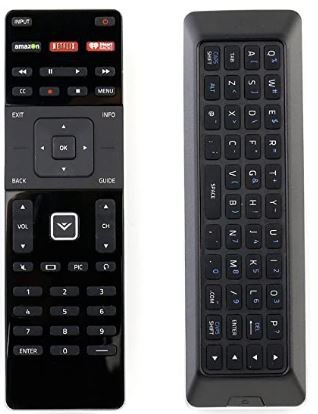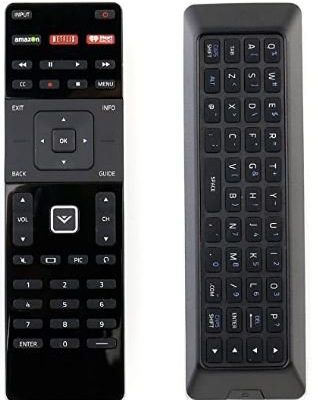
Honestly, it’s a bit like trying to use a house key from your old place on a brand-new door. Sometimes it slips right in and works. Other times, no luck—unless you have the master key, or in this case, a universal remote. If the world of TV remotes, codes, and syncing makes your head spin, don’t worry—I’ve spent far too many hours chasing these answers, so you don’t have to.
Understanding Vizio TV Remotes: What Makes Them Unique?
Here’s the thing: Vizio TV remotes are designed first and foremost for Vizio TVs. That means they use certain infrared (IR) frequencies, and some newer ones add Bluetooth for quicker, smarter control. Actual smart remotes—a bit of an upgrade from your classic “clicker”—can do more than just change channels or adjust the volume. Many come with shortcut buttons for apps (think Netflix, Hulu), voice commands, and even a sleeker design for your hand.
But, not every Vizio remote is built the same. The ones you get with older Vizio TVs are strictly IR: you point and shoot, and if something blocks the sensor, well, nothing happens. Newer ones, especially those for Vizio’s “SmartCast” models, might use both IR and Bluetooth. That’s cool, but it also means compatibility gets a little trickier when you try to pair a remote with a smart TV—especially if that TV is from another brand or a newer model with different features.
So, here’s the first rule: a *basic* Vizio remote often works with other Vizio TVs, but not always with smart TVs from other brands. And if your Vizio smart TV uses advanced functions (like voice search or app shortcuts), not every old remote will keep up.
Vizio Remote Compatibility with Vizio Smart TVs
You might be wondering, “Will my old Vizio remote work if I upgrade to a fancy new Vizio smart TV?” The answer is: sometimes, but not always. If both TVs use similar IR codes and neither relies exclusively on Bluetooth for remote control, you’ll probably be fine. For basic commands—power, volume, channel—most Vizio remotes are cross-compatible within the brand. It’s like swapping out light bulbs between lamps; as long as the socket fits, you’re in business.
But, if your new Vizio smart TV came with a slick remote packed with buttons for apps, voice functions, or menus, those features may not work with your trusty old remote. Why? Because older remotes simply don’t “speak that language.” Advanced features often require Bluetooth pairing or extra coding that only newer remotes (or universal remotes) can handle.
If you want the full experience—voice commands, app shortcuts, lightning-fast navigation—stick with the remote your smart TV came with, or upgrade to a compatible newer model.
And here’s a pro tip: If you ever reset your TV or the remote, you might need to pair them again. Luckily, Vizio usually makes this pretty simple—often a button combo to sync things up. The user manual (or a quick Google search) comes in handy here.
Can Vizio Remotes Work With Non-Vizio Smart TVs?
Let’s get this straight: a standard Vizio TV remote is not a universal remote. If your TV says Samsung, LG, Sony, or TCL on the front, a Vizio remote probably won’t work—at least not without some magic. Every brand uses its own remote codes and communication methods. Some smart TVs even add WiFi or Bluetooth connections to the mix, making the puzzle trickier.
It’s a bit like expecting your car key to start your neighbor’s vehicle. Sure, both are keys, but the coding inside is unique. Some very basic universal remotes can be programmed to work across brands using special codes, but regular Vizio remotes won’t cut it for cross-brand compatibility.
Now, if your non-Vizio smart TV specifically supports “universal remote” syncing, you *might* be able to program it—if you get a generic IR-based universal remote and input the right code. But a dedicated Vizio remote? No dice. To control other brands’ smart TVs reliably, you’ll want a true universal remote, or just use the remote provided by the TV manufacturer.
Pairing and Syncing Your Vizio Remote: How It Works
Here’s where most folks get tripped up. If you just bought a replacement remote or you’re re-pairing after a battery swap, the pairing/syncing process matters. Older Vizio remotes, which work purely via IR, don’t need to be “paired”—you just pop in batteries and go. But the newer Vizio remotes, especially SmartCast models, sometimes require you to sync (or pair) them using Bluetooth.
Usually, the TV will prompt you through the process: “Press and hold the X and Y buttons for 5 seconds to pair your remote.” Sometimes you’ll see a blinking LED on the remote, or an on-screen message, to confirm you’re in sync mode.
Don’t forget: If your remote isn’t responding, sometimes it’s a battery issue, not a pairing problem. Swap in a fresh set before you start troubleshooting codes or connections.
If you ever hit a wall, there’s always a little reset hole or hidden combo that puts the remote back to factory settings. Just remember that after a reset, you’ll need to run the pairing process again if it’s a Bluetooth remote.
Troubleshooting: When Your Vizio Remote Won’t Work
Some days it feels like technology just has a mind of its own. You’re pressing buttons, but nothing’s happening. Here’s a quick checklist to save your sanity:
- Check the batteries. Obvious? Maybe. But it’s the
- Reset the remote. Look for that tiny reset hole, or Google the button combo for your model. It clears up a surprising number of problems.
- Clear the line of sight. IR remotes need a direct path. Move coffee mugs, pets, or snacks that might be blocking the way.
- Re-pair (sync) the remote. For newer Bluetooth SmartCast models, try the pairing steps again. Sometimes it just needs a fresh handshake.
- Check TV settings. Some smart TVs let you enable or disable certain remote features—especially Bluetooth or voice control. Make sure your settings match what you’re trying to use.
And just to say it: Sometimes remotes just plain die. If you’ve tried everything and it’s still a dud, it might be time to order a replacement.
Universal Remotes vs. Vizio Remotes: What’s Best for Smart TVs?
Here comes the million-dollar question: Should you stick with brand remotes or grab a universal one for your smart TV setup?
Vizio remotes are great if you’re using a Vizio TV and you want all the original features. They’re straightforward, and you don’t have to mess with codes or programming. But they’re limited—they won’t control your soundbar, gaming console, or other non-Vizio gear.
Universal remotes, on the other hand, are like the Swiss Army knife of control. They can be programmed (with codes or sometimes even just a learning mode) to run all your devices, from smart TVs to streaming boxes. Some pricier models even have touchscreens or voice control. If you’re juggling more than one brand of device, a good universal remote is a lifesaver. Just remember, you’ll need to enter the right code for each device, but most decent remotes come with a thick book—or an online database—that makes this part pretty painless.
Replacing a Lost or Broken Vizio Remote: Easy Options
Let me guess: the couch monster ate your Vizio remote, and now you’re stuck hunting for a replacement. Don’t panic. You’ve got a few solid options.
- Buy a genuine replacement: Vizio sells original remotes online. They work right out of the box—no pairing headaches.
- Try a third-party remote: Some affordable knock-offs on major retailers work just as well for basic features.
- Use your smartphone: If your Vizio smart TV supports SmartCast, you can download the Vizio SmartCast app and control your TV with your phone. It’s surprisingly handy when you can’t find batteries or don’t want another remote lying around.
- Go universal: If you have other tech to control, a universal remote is a great investment. Just make sure you grab one that lists “Vizio” among its supported brands—and keep the code booklet somewhere safe.
Pro tip: If you need to quickly mute an obnoxious commercial or change the input, the phone app is a lifesaver while your replacement remote ships.
Common Use Cases: How People Actually Use Vizio Remotes With Smart TVs
Let’s paint a few real-world scenarios. Maybe you’ve got an older Vizio remote and just bought a 4K Vizio smart TV. You want things to “just work”—especially the basic functions. In most cases, your remote will cover the essentials: power, volume, input. But to open apps or use voice commands, you’ll probably need a newer remote.
Or maybe you’re trying to control a bedroom TV with a living room remote. If both are Vizio and roughly the same age, you’re golden. But if one is “smart” and the other’s a decade old, function gaps appear. It’s not just about brand—it’s about age, features, and technology inside the remote itself.
And for households that “mix and match” TV brands, honestly, you’ll want a universal remote. It’s the only way to keep things simple and avoid the classic “which remote goes to what?” confusion during family movie night.
Final Thoughts: Making Sense of Vizio TV Remote Compatibility
So, bottom line: Vizio TV remotes generally work best with Vizio TVs, and they’re especially reliable for basic functions—power, volume, channel. For smart functions on Vizio’s own smart TVs, you’ll want to stick with the latest compatible remote to unlock everything, from voice controls to streaming shortcuts. Don’t expect them to work on non-Vizio smart TVs, and definitely don’t expect them to work across brands like a universal remote would.
If you’re wrestling with pairing, codes, or just plain confusion, don’t stress. Most compatibility issues boil down to remote age, TV model, and features required. When in doubt, check your TV’s manual, grab a universal remote, or just use your phone in the meantime. At the end of the day, the right remote means you get to kick back and enjoy your smart TV—without a tech headache. Isn’t that all any of us really want?
